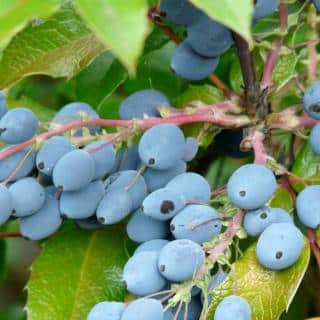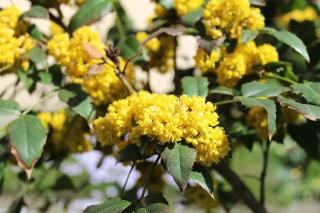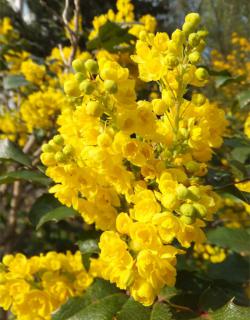

Mahonia is a simply astounding shrub during winter.
Main Mahonia facts
Name – Mahonia
Family – Berberidaceae
Type – shrub
Height – 3 to 6 ½ feet (1 to 2 meters)
Exposure – full sun, part sun, shade
Soil – ordinary
Foliage – evergreen – Flowering – winter
Yellow flowers burst forth from the deep evergreen leaves for a beautiful and delicately fragrant winter garden.
Caring for this plant from planting to pruning will ensure that you’ll have nice growth and beautiful blooming.
Plant your mahonia in fall or spring but avoid frost spells and high temperatures.
If, for any reason, you must plant it in the sun, avoid places that would be too hot and if possible favor part sun.

However, cuttings and sucker division are the easiest and quickest methods.
Prepare mahonia cuttings at the end of of the summer, on soft-wood growth.
Division from suckers is best performed in spring.
Pruning isn’t really needed but it may help make the foliage more dense or to reboost the vigor of your mahonia.

Watering must be regular albeit with small quantities during the first year, especially if it was planted in spring.
After that, watering is needed in case of high temperatures or prolonged dry spells.
In summer, mulch the base of the shrub in order to retain a certain moisture level and also avoid weed growth.
Mahonia berries are edible! They’re very tart, somewhat like currant. Despite their unique taste, adding them to fruit salad, yoghurt and other desserts is a real treat.
It’s also a great fruit to make jam and jelly.
The flowers of the Mahonia plant are also edible. Their fragrance and taste are similar, somewhat close to that of honey.

You’ll find these very appealing: ‘aquifolium’, ‘bealii’, ‘japonica’, ‘lomariifolia’ and ‘wagneri’.
Discover each of these wonderful species and cultivars here:
The two hardiest Mahonia species are Mahonia aquifolium and Mahonia repens. These even survive the harsh winter colds of Siberia! They originally grew in certain regions of North America, in the Northwest – hence the common name for these species, “Oregon grape holly”.
Although cross-pollination doesn’t often result in hybridization, several astounding mahonia hybrids are available in nursery stores.
Other outstanding mahonia varieties include:
You can even nurture dwarf mahonia cultivars in pots on a terrace or balcony.
The name “Mahonia“ was chosen to honor the American botanist Bernard Mc Mahon.
The spectacular blooming of mahonia makes it one of the rare shrubs to bear such floral bunches over winter. It matches that of the taller winter mimosa tree.
With its very ornamental appearance, this prickly, leathery-leaved shrub will appeal to you anytime of the year. As an added surprise, you’ll discover that the flowers are deliciously scented! They release a honey-like smell that is even more fragrant during the night. Perfect for any fragrant garden!
Mahonia fears neither cold nor freezing since it can withstand temperatures falling to -4°F (-20° C).
There are many benefits to growing a Mahonia shrub in your garden. Of course, the bees we mentioned above relish its nectar, but there are also many other reasons:
Read also:
Plant daffodils or yellow tulips at the base of the tree to create clustered spots of color in winter.
The one in my garden is so fragrant! I’m not sure if they all smell the same. I sure hope so. I noticed mine had a stronger scent in the afternoon.